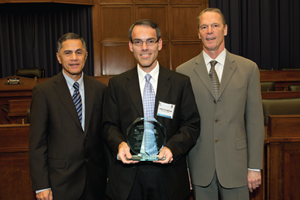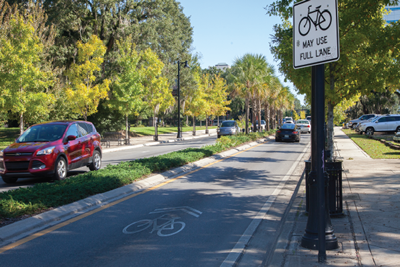U.S. Department of Transportation
Federal Highway Administration
1200 New Jersey Avenue, SE
Washington, DC 20590
202-366-4000

Welcome to the inaugural edition of the Road Diet Quarterly Update. Our intent with this publication is to share updates from the FHWA Road Diet program, share insights from Road Diet practitioners, keep you up to date on projects across the country, and see what they're saying in the media.
As many of you know, Road Diets can be a low-cost solution for more livable communities and safer roads for ALL users. Over the last few decades, many cities and communities have evolved to be primarily car friendly. And while providing safe accommodations for vehicles are important, we must consider the overall needs of the public including bicyclists, pedestrians and transit riders. Road Diets are a unique tool that states and local transportation authorities can used to reconfigure a roadway and provide space for bicycle lanes, sidewalks, on-street parking or transit stops.
Keep reading for an interview with Randy Dittberner, a Regional Traffic Engineer with the Virginia Department of Transportation (VDOT), who recently received a 2015 National Roadway Safety Award for two Road Diet implementations in Northern Virginia.
We look forward to sharing more about Road Diets and how they are being implemented across the U.S. in upcoming issues of the newsletter.
For more information on Road Diets, please visit: https://www.fhwa.dot.gov/innovation/everydaycounts/edc-3/roaddiets.cfm Join our mailing list to make sure you receive future Road Diet Quarterly Updates.

Randy Dittberner is a 2015 recipient of a National Roadway Safety Award for Infrastructure and Operational Improvements. This award, jointly sponsored by the FHWA and the Roadway Safety Foundation, recognizes roadway safety achievements that help reduce fatalities and serious injuries on the Nation's roadways.
Dittberner is a Regional Traffic Engineer at VDOT. The National Roadway Safety Award was presented for two Road Diet projects that have reported a nearly 70 percent reduction in crashes since implementation. During a Q&A with us, he spoke about these award-winning projects, as well as some of the general benefits and challenges of implementing Road Diets.
The award was for two projects in Reston, Virginia. The first, on Lawyers Road, was completed in 2009, and the second, on Soapstone Drive, was completed in 2011.
The two projects were very similar. In general, our concept was to take away one thruway in each direction. We were able to take some of that pavement and realign it. We took a road that was more car-centric and created one that was safer for all users.
The first was much more challenging from an outreach perspective. There was some opposition as the public was not familiar with its treatment. So, we had to do a lot of outreach to familiarize people with what this project would mean for their community.
The crash reduction has been far greater than expected. National studies show that Road Diets usually reduce crashes by 20 to 50 percent, but on the first project, crashes dropped by an astonishing 69 percent in the first 5 years. On the second one, crashes dropped 67 percent in the first 3 years.
There are many Road Diets projects where the engineering really is a challenge. For these two projects in Reston, that was not the case. When we looked at the traffic numbers and information, we were really confident that this would work.
Our biggest challenge was public outreach and trying to convince the public how this could improve their community. But we proceeded carefully. We didn't want to go out and tell neighbors what they think their streets should look like. We want them to have input, and we got strong support.
I grew up in Arizona. When I was a student in college, there was a Road Diet installed right in the middle of campus. I was able to witness it in first person and get a sense of the street. I saw the impact and sense of community it could produce. The improvement, the feel, the sense that you get from a Road Diet, and I became a believer.
I was further convinced when a Road Diet was installed on the street right in front of my house. I had a chance to go to the public meetings and hear about it from the standpoint of a community-member.
There are conventional Road Diets, like the Reston projects where you turn four lanes into three. It's the most common type of Road Diet, and what most people think of when they hear the term.
First we look at the amount of traffic. There aren't specific guidelines, but I think the upper boundary is within 18,000 to 20,000 vehicles a day. If there is more traffic than that, we don't consider a Road Diet.
Second, we look at intersections along the way. We check the timing of traffic signal operations and cross-traffic in the intersection.
Third, we look at the objective: Are there a lot of crashes and can we improve safety? Do we want to improve bike accommodations or implement a bike master plan? Is it about encouraging more community livability?
Keep Road Diets on the agenda as a great treatment.
Make sure you look at every street when it gets paved. That would be a perfect opportunity to determine whether there is a need for a Road Diet.
I would also encourage other engineers to check the Road Diet Informational Guide by the FHWA. It's a great tool to learn about candidate, design, implementation, and evaluation.
I think a Road Diet is a tool that needs to be in every traffic engineer's tool box. Though, it's not a cookie-cutter approach—there are lots of different permutations.
The nice thing about Road Diets is that they are flexible and they give you a lot of choices.
If you can build a Road Diet with a paving project, you can do it with almost no cost. You can have a huge safety benefit, livability benefits, and things like bike accommodations. Why wouldn't you want to do it when you have all of these benefits?
See a related news article about Dittberner's award:
VA Road Relief Project Receives National Award
WTOP News – The D.C. region is notorious for terrible traffic, especially parts of northern Virginia, but there have been some innovative ideas aimed at relieving congestion and improving road safety.

On October 29, 2015, FHWA partnered with the Virginia Local Technical Assistance Program (VA LTAP) to provide a Road Diet Workshop in Roanoke, Virginia. Over 30 people, including engineers, planners, and transportation safety specialists from state and local agencies participated in the event. Topics of discussion ranged from Road Diet benefits to feasibility and evaluation.
The workshop included a field exercise where participants implemented a Road Diet on nearby Williamson Road. Mr. Mark Jamison, Manager of Transportation for the City of Roanoke, provided background and crash data for the location. Each group provided a reconfiguration of the roadway and were required to present and defend their plan.
Overall, the workshop was a great success with many positive responses. If you're interested in a Road Diet Workshop for your region, please contact Keith Harrison at Keith.Harrison@dot.gov.
Each quarter we'll take a look at where Road Diet projects are being discussed and implemented across the country.
Tennessee: The Nashville Area Metropolitan Planning Organization (MPO), the Tennessee Department of Transportation, and the US Department of Transportation Office of Safety held a Road Safety Audit Review (RSAR). There was considerable discussion about how Nashville has used Road Diets to improve bicycle accommodations throughout the City.
Massachusetts: Massachusetts received a grant to develop Road Diet policy and performance measures from the FHWA State Transportation Innovation Council (STIC) Incentive program. The STIC Incentive Program provides resources to help STICs make innovations standard practice in their States.
New Mexico: New Mexico plans to institutionalize Road Diets and develop a statewide policy on Complete Streets. They have spent countless hours identifying opportunities to implement Road Diets where appropriate and desired by local communities, and where local plans exist to support their function.
CBS Los Angeles – Matlock Grossman wants to remind drivers they share the road… His frustration has grown so bad he took his concerns to the Silver Lake Neighborhood Council.
The Gazette – Road diets are an increasingly popular tool to change driving habits. With a little paint and re-imagining the use of space, Iowa City officials eliminated two travel lanes from a congested four-lane road — two lanes in each direction — with entrances to a mall, a college campus and factories.
is a publication of the U.S. Department of Transportation, Federal Highway Administration.
The Federal Highway Administration publishes the Road Diet Quarterly Update four times a year. We can be reached at
FHWA Office of Safety
New Jersey Ave. SE
Washington, D.C. 20590
The Road Diet Quarterly Update is available online at the FHWA Office of Safety Website safety.fhwa.dot.gov/road_diets
We welcome your comments and Road Diet safety-related articles. The purpose of this newsletter is to increase awareness and provide information and resources of Road Diets to local and state transportation authorities as well as the general public.
We encourage readers to submit articles that might be of value to the Road Diet stakeholder community. Send your comments, questions, and articles for review electronically to Becky Crowe at rebecca.crowe@dot.gov
